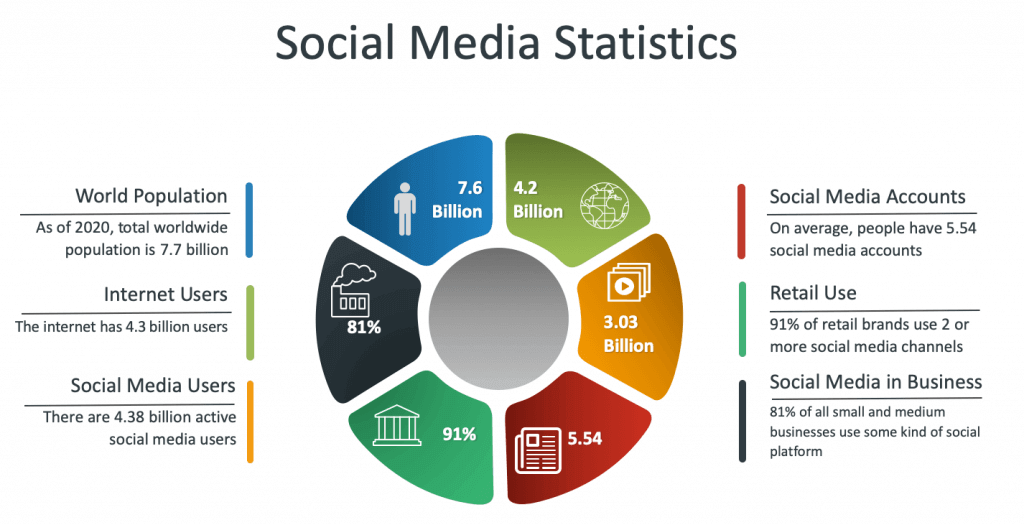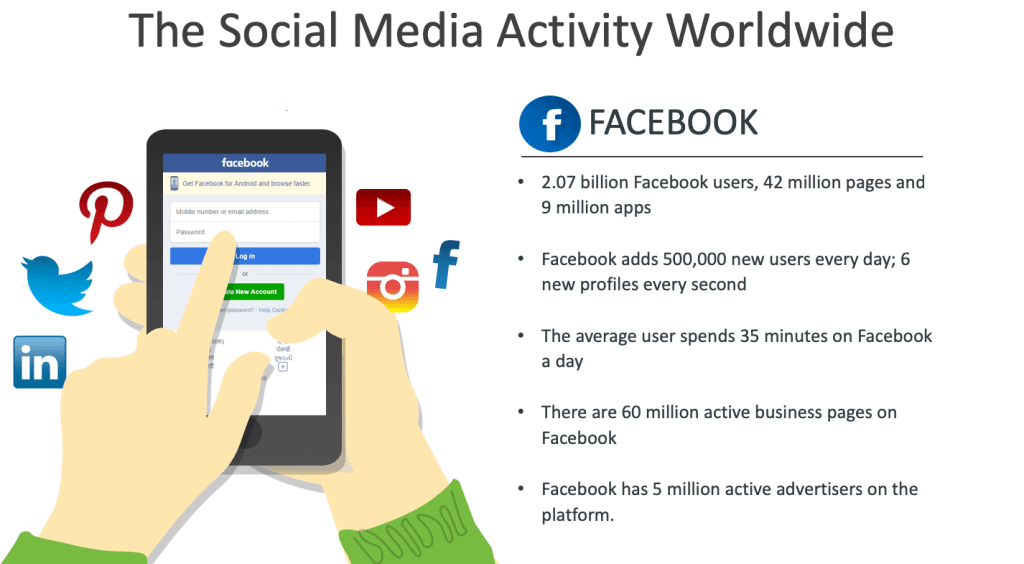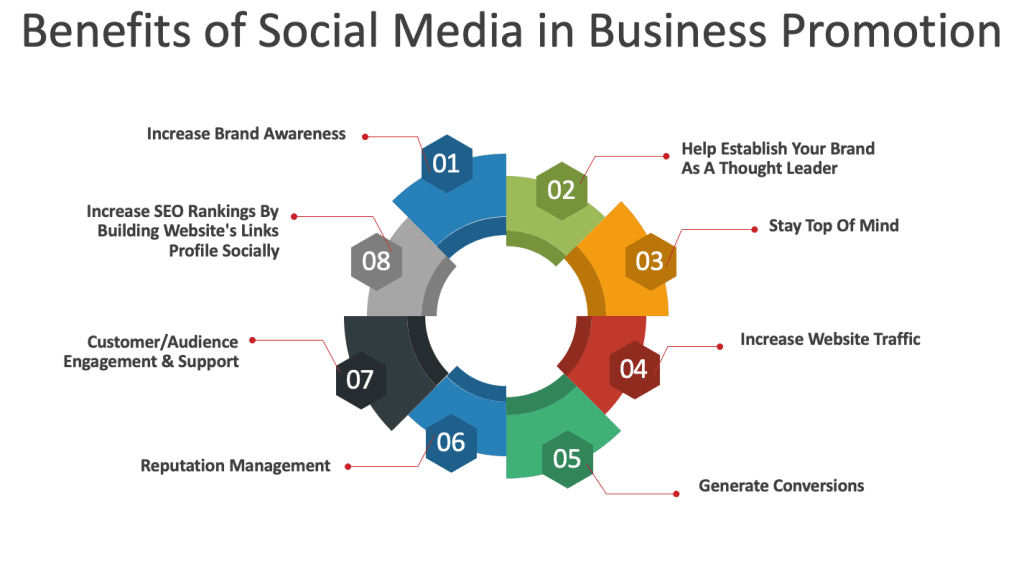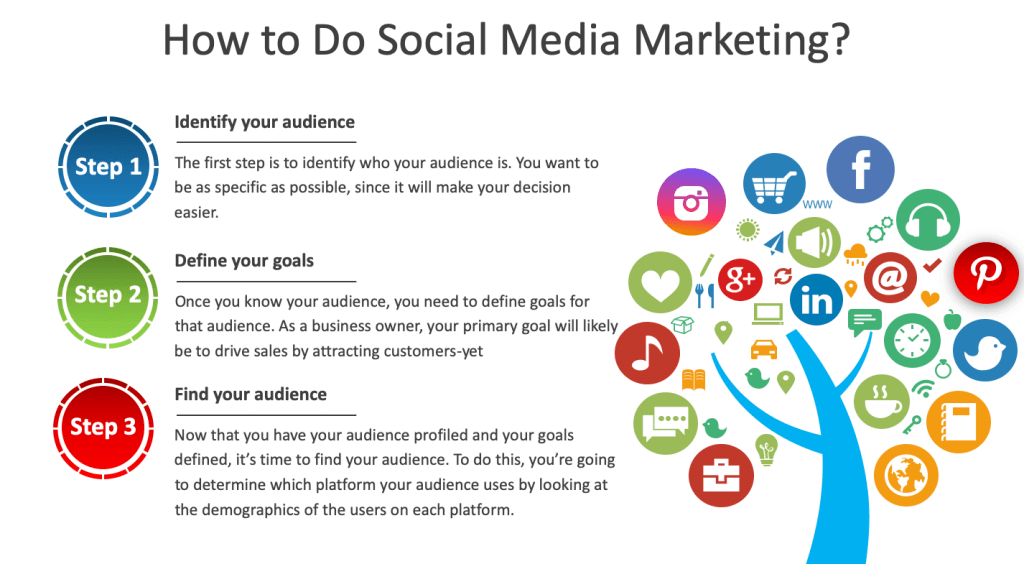Social media management goes beyond just posting updates to your company’s social media profiles. It also includes engaging with your audience and looking for new opportunities to increase reach and visibility.


Some Useful Social Media Statistics
World Population – As of 2023, total worldwide population is 8 billion.
Internet Users – The internet has 5.3 billion users
Social Media Users – There are 4.9 billion active social media users
Social Media Accounts – On average, people have 5.54 social media accounts
Retail Use – 91% of retail brands use 2 or more social media channels
Social Media in Business – 81% of all small and medium businesses use some kind of social platform


Popular Social Media Channels


Facebook has the largest monthly active users who come from diverse backgrounds. There is also a nice balance of genders and age groups when it comes to Facebook’s user-base. This makes it a great social platform for businesses that are trying to reach a wider audience.
YOUTUBE


YouTube has become the second-largest search engine in the world, second only to Google. With unlimited video hosting, your business can post as much video content as you want and share through other channels.


LinkedIn is the social media platform for B2B brands that are targeting businesses in different industries. With LinkedIn, you can find, interact, and share content with people based on your company type, industry, or job title.


Twitter has 330 million active users worldwide and tends to be where users go for news and trends. This platform is ideal for brands that want to join a conversation about trending topics in their industry & a great place to share content with influencers and other individuals who might find your brand valuable. media accounts


Instagram is a great social media channel for brands that create a lot of visual content. Instagram’s audience tends to be on the younger side with more female users than male users. This can be a great platform for businesses selling products or services related to fashion, lifestyle.


Pinterest is another great channel for sharing image-focused content. This has become a must for consumers who are interested in DIY, crafts, home improvement, nutrition, fitness, fashion, and more. If your brand sells a product or service that lends well to imagery, then Pinterest may be worthwhile.


The Social Media Activity Worldwide
- 2.41 billion Facebook users, 42 million pages and 9 million apps
- Facebook adds 500,000 new users every day; 6 new profiles every second
- The average user spends 35 minutes on Facebook a day
- There are 60 million active business pages on Facebook
- Facebook has 5 million active advertisers on the platform.


- There is a total of 1.3 billion accounts, but only 330 million are active
- The average Twitter user has 707 followers
- There are 500 million Tweets sent each day. That’s 6,000 Tweets every second


- There are 1 billion Monthly Active Users on Instagram
- The average Instagram user spends 15 minutes a day on the app
- 90 per cent of Instagram users are younger than 35
- 24% of US teens cite Instagram as their favourite social network


- Interest has 291 million active users each month
- 67% of Pinterest users are under 40-years-old
- In 2014, the male audience grew 41% and their average time spent on Pinterest tripled to more than 75 minutes per visitor


- LinkedIn has 500 million members
- 106 million of those access the site on a monthly basis
- Over 3 million companies have created LinkedIn accounts
- As of July 2, 2018, there are 24.5m company pages on the platform


YOUTUBE
- YouTube is the world’s second-largest search engine and third most visited site after Google and Facebook
- People now watch 1 billion hours of YouTube videos every day
- In an average month, 8 out of 10 18-49 year-olds watch YouTube
- More than half of YouTube views come from mobile devices
- YouTube sees around 1,148bn mobile video views per day


Using Social Media for Business Promotion
According to a survey published on HootSuit.com, There are more than 3 billion people using social networks across the globe. Also, people follow brands on social media than follow celebrities. On Instagram alone, 80 per cent of people follow at least one business.


Benefits of Social Media in Business Promotion
Here are some of the benefits of using social media as the core marketing tool:
- Increase Brand Awareness
- Increase SEO Rankings By Building Website’s Links Profile Socially
- Customer/Audience Engagement & Support
- Reputation Management
- Help Establish Your Brand As A Thought Leader
- Stay Top Of Mind
- Increase Website Traffic
- Generate Conversions


Organic Vs Paid Social Media Marketing
Difference between Organic & Paid Social Media
What is Organic Social Media?
Organic social media is anything that happens on social media without paid promotion. When you post as your page but don’t put any money behind this post to “boost” it, you are creating an organic post. If you comment on a business’s post in your news feed, and the “Sponsored” tag does not appear on the post, that action qualifies as organic. In other words, organic actions occur on non-ads.
Organic marketing on social media is perfect for building your brand.
If you regularly post valuable content, you will engage and grow your audience. Each post is an asset that increases your brand’s value in the eyes of your followers.


What is Paid Social Media?
Paid social media is anything that is influenced by advertising dollars spent. Any post in your news feed that has the “Sponsored” tag is paid social media. If you then “like” that post, that is considered a paid reaction. Paid social media includes boosted posts, ads optimized for clicks, lead generation forms, video ads, among other objectives, and can be targeted by a variety of demographic and behavioural factors.
Unlike organic marketing, paid social media doesn’t suffer from limited penetration. Compared to the ‘post and wait’ dynamic of organic marketing, paid social guarantees that your ad will be seen.


How to Do Social Media Marketing?
Identify Your Audience
The first step is to identify who your audience is. You want to be as specific as possible since it will make your decision easier.
Define Your Goals
Once you know your audience, you need to define goals for that audience. As a business owner, your primary goal will likely be to drive sales by attracting customers-yet.
Find Your Audience
Now that you have your audience profiled and your goals defined, it’s time to find your audience. To do this, you’re going to determine which platform your audience uses by looking at the demographics of the users on each platform.


Boost Your Conversions through Social
Media
1. Schedule Your Social Media Interactions
One of the great things about social media is that you could have followers from all over the world.
Try to engage with the audience & interact with them using posts& scheduled webinars.
2. Make Your Social Content Informative
Your social media content needs to provide a solution or at least some usefulness in order to be considered valuable.
The user gets engaged with informative posts.
3. Create Captivating Headlines
That said, the solution to emotive hype is not dullness or boredom. You still need to captivate the attention of your audience. And the first and often last place to do that is through your headlines. Your headline is easily one of the most important parts of your content.
4. Pay Attention to What’s Working
To know what’s working you need to track your shares and social media content and understand how to utilize your analytics data.
There are significant tools that can help you in monitoring the results of your strategy, such as Kissmetrics and Google Analytics. These tools can help you save a lot of time in the long run by avoiding guesswork.
5. Ensure Links Point to Relevant Landing Pages
By landing pages, I don’t necessarily mean sales copy: Single full-width pages with an advertisement. A landing page is a page you want the site visitor to land on and should be relevant to the link on social media.




Best Time to Post on Social Media
- Best time to post: 12-4 PM
- The best day(s) to post: Wednesday, Thursday, Friday
- Best time to post:- 12 PM
- The best day(s) to post: Monday, Tuesday, Wednesday, Thursday
- Best time to post:12 -1 PM
- The best day(s) to post: Wednesday, Thursday, Friday, Saturday, Sunday
- Best time to post: 11 AM-1 PM, 2 AM (really!)
- The best day(s) to post: Monday, Wednesday, Thursday, Friday
- Best time to post: 5-6 PM
- The best day(s) to post: Tuesday, Wednesday, Thursday


Conclusion
Small businesses can employ social media strategies to connect with and engage existing and potential clients, providing intriguing content while spreading the word about their products and services. As more people rely on recommendations from friends and family to make purchase decisions, it is in the best interest of most small businesses to develop and maintain a vibrant and engaging social media presence.
Related Posts
How To Do Instagram Marketing – A Start To Finish Guide



Hi there. I discovered your website by way of Google whilst looking for a comparable matter, your site came up. It appears great. I have bookmarked it in my google bookmarks to come back then.
Thanks Kathi!
Like!! Great article post. Really thank you! Really Cool.
Thanks Sonyo.
Everyone loves what you guys are usually up too. Such clever work and coverage! Keep up the terrific works guys I’ve added you guys to blogroll.
It’s fantastic that you are getting ideas from this piece of writing as well as from our dialogue made at this place.
Thanks Sophia.
Hello! Someone in my Myspace group shared this site with us so I came to take a look. I’m definitely enjoying the information. I’m bookmarking and will be tweeting this to my followers! Outstanding blog and superb style and design.
Thanks Stewart.
I savour, cause I discovered exactly what I was having a look for. You have ended my 4-day long hunt! God Bless you, man. Have a nice day. Bye
Thanks Tito.
Appreciate the recommendation. Let me try it out.
Good luck Ernie!
Currently, it seems like Movable Type is the preferred blogging platform out there right now.
You are right Jijy.
You really make it appear so easy along with your presentation but I in finding this topic to be really something that I feel I’d by no means understand. It sort of feels too complex and very extensive for me. I am having a look forward in your subsequent publish, I will try to get the dangle of it!
You’re so cool! I don’t believe I’ve truly read through something like this before. So wonderful to find another person with some original thoughts on this subject matter. Really.. many thanks for starting this up. This web site is something that is required on the internet, someone with a bit of originality!
Hi mates, it’s a fantastic post about tutoring and entirely defined, keep it up all the time.
Thank you for the auspicious writeup. It in fact was a amusement account it. Look advanced to far added agreeable from you! However, how can we communicate?